euk diversity midterm
1/190
There's no tags or description
Looks like no tags are added yet.
Name | Mastery | Learn | Test | Matching | Spaced |
|---|
No study sessions yet.
191 Terms
bioprospecting
using natural resources to make commercially viable products. can be good bc finding new things to make out of natural resources, but can lead to overharvesting from local economies and natural resources.
‘evolution as progress’
the idea that all living things go in a linear organization, and the best things are evolved now…. this is wrong. selection cannot predict the future, only act on what is present.
aristotles view on evolution
plants and animal are the most complex and developed organisms. they are divine and unchanged (no evolution, god created them perfect).
anton van leewenhoek ideas
father of microbiology, discovered the very small stuff around us by creating the compound microscope
carl linnaeus
thought that organisms were divinely made, but proposed naming and classifying organisms
“nested hiearchy”, naming and classifying organisms in folders of folders
created kingdom, phylum, families, etc in binomial nomenclature
What is the difference between monophyletic, paraphyletic, and polyphyletic
groups? Which group do we strive for when constructing phylogenies? How does
convergent evolution influence phylogeny?
Monophyletic: a CA and ALL of its ancestors
Paraphyletic: CA and SOME of its ancestors
Polyphyletic: decendants of more than 1 CA
We strive for
charles darwin
evolutionary view of life, organisms are related and they branch out instead of humans being the perfect form.
haeckel *
coined the term, protista, for the third kingdom of life. i.e. organisms that dont fit animal or plant.
whittaker *
proposed a fifth kingdom of life: prokaryotes in the kingdom monera, protista became the trashcan taxon
woese: *
split the monera kingdom into archaea and bacteria, and split life classification into three domain (bacteria, archaea, and eucarya, we are in eucarya)
what is the protista problem?
animal, plant, and fungi are monophyletic groups. but, protista is a paraphyletic group that has alot of randos thrown in
protista is very morphologically diverse
eukarya domain
most are unicellular protists
algae (plant like)
protozoans (animal like)
true multicellular is only in animal, plant, and fungi
how to determine phylogeny
morphological data or dna
hypothesis based on this ^
molecular data is very helpful!
ancestral traits
derived character states
arise in evolutionary lineage later (new traits)
phylogeny time scales
trees can be overlaid on each other
homology
similar traits in organisms bc of CA
homology vs convergent evolution
homology is actually bc of sharing a CA, convergent is bc of analogous structures, similar environments evolves similar structures.
there is no shared ancestry in convergent!! independent of each other
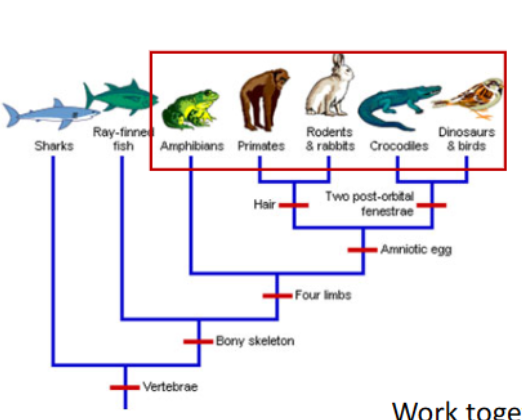
who is the sister taxon to primates? to amphibians?
primates sister taxa is rodents and rabbits. amphibians sister taxa would be most likely primates.
primate phylogeny
is a paraphyly! prosimians, new world monkeys, old world monkeys, and apes
the monophyly: simiiformes, with new world monkeys, old world monkeys, and apes in them
prosimians
before monkeys and apes
new world
south and central america
spider monkeys, capuchins
old world monkeys
baboons
afr and asia
apes
chimps, gorillas, orangutans, gibbons
what type of group is reptiles?
paraphyletic, doesnt include birds but has snakes, turtles, crocs, etc
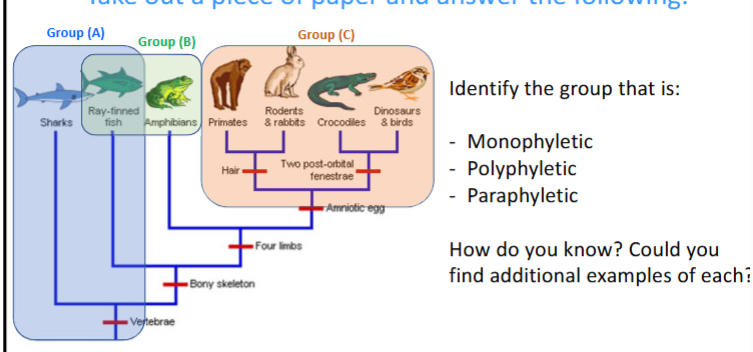
mono: group c
para: group A
poly: group B
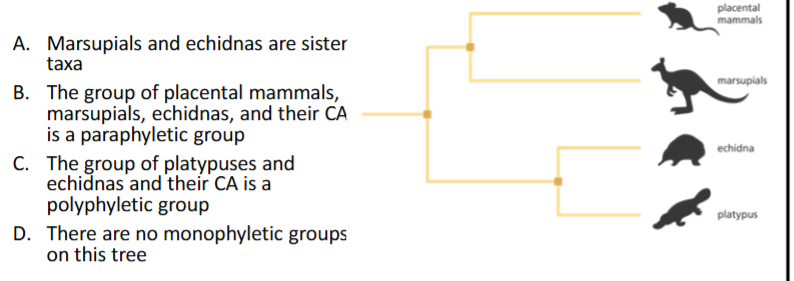
which is true?
B.
geological record*
archaen eon: first cells
proterozoic eon: first euk cells
phanerozoic eon: most extensive fossil reocrd, not many good fossils
paleozoic
ancient animals and life
mezosoic
middle life, age of dinos
cenozoic
recent life
mammals and birds, flowering plants
key events of geologic record *
earth formed 4.6 BYA
prok 3.5 BYA
unicellular eul 2.1 BYA
multicell 1.5 BYA
humans originated 195k YA
five mass extinctions
extinction= period of very high species loss
permian extinction was the biggest mass extinction (90% ocean species)
over time, the number of taxonomic families has increased, partly bc of better fossil record
fifth mass extinction
killed the dinos! 65 MYA, main theory is that an asteroid hit the gulf of mexico, debris cloud blocked out the sun
led to dominance of flowering life forms and bird diversity afterwards
earliest animals:
edicarian fauna, 600 MYA
ground plans for animals in cambrian explosion*
540 MYA in cambrian explosion, 100 diff animal phyla evolved
many are now extinct, abt 99% of all animals extinct
organisms were weird looking, evolution was experimenting lol
early plant life and sig
475 MYA on land, now there is 290k living species
sig: supply oxygen, base of land animal chains, not live without it
mosses were early land plants and dominant in first 100MY
when did vascular plants diversify
350 MYA, caroniferous time. created the coal!!! early tetra like reptiles and amphibians lived in these
primary endosymbiosis
when a larger host engulfs a prokaryote
first
created heterotrophic eukaryotes with hetero prokaryote
became the mitochondria!
also infolded and made the nuclear membrane, not as important
second
created autotrophic eukaryotes! plants
the new heterotrophic euk engulfed a photosynthetic prokaryote
created the chloroplast
these are both primary endosymbioses bc the prokaryote was directly engulfed by a host cell!!
evidence for primary endosymbio
prok and mitochondria/plastid:
similar sizes
have binary fission
single circular chromosome
internal membranes
prok and euk similarity
RNA and DNA as genetic material
ribosomes
lipid bilayer cell membrane
similar amino acids and sugars
in what supergroup did 2nd primary endosymbio happen?
archaeplastida! this has red and green algae and ALL land plants in it
NOT BROWN ALGAE!
what performs photosynthesis with secondary endosymbiosis
kelp AKA BROWN ALGAE (multicell marine)! not any of the other stuff, just some protists/euk like euglena and dinoflagellates (red tide plankton AND zooxanthellae)
secondary endosymbiosis
evolution of protists with plastids
a larger host engulfing a eukaryote with photosynthetic thing in it already
indirectly got photosynthesis too
led to other photosynthetic eukaryotes aka protists!
euglena
dinoflagellates
brown algae
archaeplastida supergroup*
primary endosymbionts!!
red algae
red pigment absorbs blue light, can grow in deep waters
coastal tropical waters
caco3 corraline type is a reef builder
green algae
aquatic, fresh and saltwater but also on land (think its on koalas)
can be unicell, multicell, colonial
includes chlorophytes and charophytes!!
charophytes are sister taxa to land plants
five euk supergroups*
protists are spread out across all supergroups
funig and animals are in unikonts
basal polytomy
the root of all euk is unknown
archaeplastida
where land plants emerge (sister taxa to charophytes)
photosynthetic organisms
primary endosymbio
where secondary endosymbionts STOLE the chloroplasts from
excavata (1)
chromalveolata (2)
rhizaria (3)
archaeplastida (4)
unikonts (5)
moss
a true bryophyte is an actual moss!!! other things that flower and have vascular systems or ferns are NOT moss

excavata supergroup
unicellular protists
share similar cell structure
some photosynthetic
euglena
some lack mitochondria bc endoparasitic
O2 poor environments
lost the mitochondria
diplomonads and parabasalids
chromalveolata supergroup*
includes two supgroups
first grouped together bc of morphology, but then confirmed by molecular data
alveolates
diverse unicellular
dinoflagellates
marine plankton: red tide and zooxanthellae
apicomplexans
parasites of humans and other animals (malaria, toxoplasmosis parasites)
ciliates
unicell heteros
have an oral groove like a mouth, repro by conjugation
ex: paramecium
stramenopiles
mostly photosynthetic algae
brown algae
“seaweed”
diatoms
silica walls
photosynth marine plankton
oomycetes
decomposers or parasites
rhizaria
amoebalike with threadlike pseudopodia to move and capture prey
marine and fresh water plankton
extend thru openings in shell
forams
pseudos extend thru CaCO3 shell
radiolarians
pseudos radiate from a silica shell


what is this
chromalveolata, is a diatom (stramenopile), secondary endosymbiosis, close to brown algae
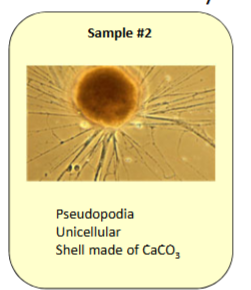
what is this
rhizaria, is a foram.

what is this
in supergroup excavata, is a euglena. secondary endosymbiosis!! euglena are not related to brown algae!!!!
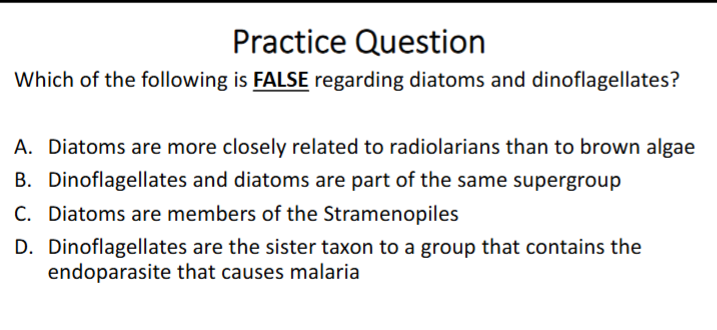
A.
what type of group is green algae?
paraphyletic. it includes chlorophytes and charophytes, but NOT land plants which it also shares a common ancestor with.

land plant traits shared with charophytes
synthesizing cellulose in cell walls thats different from other algae
phragmoplast forms in cell division
group of microtubules
cell plate develops to make cell wall`
what are embryophytes and why
they are land plants! 475 MYA moved to land
called that bc they are adapted for terrestrial life, mainly reproduction adaptations
adaptations
diversification of land plants and key events*
charophyte—> non vascular bryophytes aka moss —> seedless vascular (ferns) —> seeded vascular (cycads, then angios)
origin of land plants at start of embryophytes with bryos
vascular system evolved aka xylem and phloem with seedless vasculars
origin of seed in angio and gymno evolution with seeded vascular
xylem and phloem
xylem
transports water
phloem
transports nutrients
they are vacular tissue, evolved after bryos and distinguish a lot of land plants.
bryophytes*
NOT monophyletic, idk.
small, herbaceous, non woody
needs to live near water and get watered a LOT bc reproduction is still tied to water sperm swims to egg
liverworts
liver shaped
sporophytes are small (no photo)
hornworts
small, not a lot
sporophyte does photosynthesis with horn thing
moss
more common of bryos
elevated sporangia capsules for spore dispersing
largest bryo group
sporo no photo
lycophytes and pterophytes*
known as the seedless vascular plants, ferns baby
larger, herbaceous, and non woody
adaptations:
water for reproduction still with flagellated sperm, need moist habitats
vascular tissue finally!
xylem cells have lignin for strength
grow taller and get water and nurtients from soil bc of it
true leaves!!! light for photosynthesis
lycophytes
fern allies like club “mosses”
microphyll, spine leaves
pterophytes
larger megaphyll
ferns, horsetails, whisker ferns
advantages of being a seed plant (and land) *
much smaller ovules and pollen
develop in the parent and protected from the environment
pollen widely dispersed
sperm not dependent on water
seeds protect, disperse, and feed embryos (with cotyledons)
allow embryos to remain dormant for years
vascular seed plant categories
gymnosperms
naked seeds
conifers, cypress
are earlier in fossil record in mesozoic
angiosperms
flowering plants
seeds aka ovules in ovaries that make fruit'
came to dominate plants later (now soooo many)
gymnosperm phyla*
conifers
largest phylum
cold climates, most are evergreen
needle like leaves for H2O loss
antifreeze sap during the winter
cycads
dioecious (M and F separate plants)
second larhest
oldest known plant w insect pollinators
ginkgos
1 species…
maidenhair tree
dioecious, male plants for landscaping
gnetophytes
has sp. in Welwitschia with sp. in desert that has some of largest and oldest leaves
some ephedra plants for medicinal purposes
angiosperm flower struc
flowers create fruit from ovary
flower
petals (modified leaves)
sepal (leaf thing)
male
stamen
anther
filament
female
carpel
stigma
style
ovary!!!
ovules aka seeds inside
different angio fruits
fruits are mature ovaries that disperse seeds
fleshy
tomato, apple, orange
dry
nuts, beans, pea pods, grains
have wind water animal adaptations for dispersal (winged, edible, hairy)
angiosperm groups* eh
monocots
think: grass, one leaf thing
1/3
1 cotyledon
fibrous roots
parallel leaf veins
vascular bundle scattered
floral organ in 3s
1 pollen grain opening
eudicots
2/3
2 cotyledons
taproot (think: carrot! you like eating carrots, and cant just have one)
veiny leaves
vascular bundle ring (carrot is circular lol)
floral organ 4s or 5s
pollen grain 3 openings
monocot diversity
¼ of angios are monocots,
like orchids, palms, lillies, grasses, and corn. no secondary growth, more conservative in form too. leaves w central vein like pothos, monstera
eudicot diversity
2/3 of angios
small herbaceous flowering plants, woody shrubs, trees
similar forms by convergent evolution in diff lineages
angiosperm families
asteraceae
eudicot
sunflower family
22k sp.
orchidaceae
monocot, 20k sp.
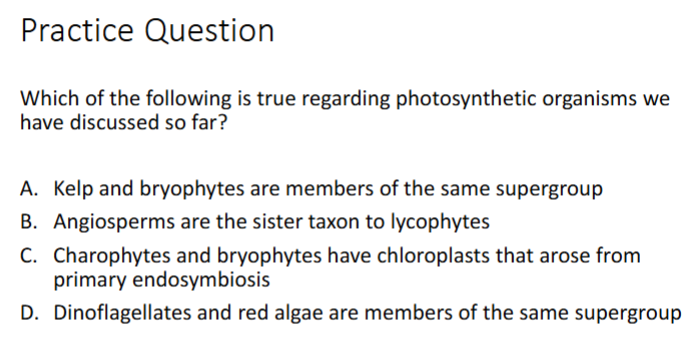
C.
Unikonts supergroup (5) *
amoebozoans
slime molds and typical amoeba
have lobe or tube shaped pseudopodia to move and engulf prey with phagocytosis
slime molds
function like a giant amoeba, creates most efficient pathways in cities similar
opisthokonts
fungi, animals, and protistan relatives
fungi relative
most related to nucleariids
animal relative
most related to choanoflagellates, sister taxa
most likely colonial choano led to multicell animals (sponges are simplest animals, similar to colonial)
suggests multicell arose independently in fungi and animals
also fungi closer related to animals than plants
fungi groups
*
chytrids
aquatic to infect amphibs,
flagellated spores
zygomycetes
fast growing bread mold
glomeromycetes
soil mycorrhizae
ascomycetes
yeasta, truffles, morels, penicillin
basidiomycetes
puffballs, shelf fungi
fairy rings!!
parasitism
sexual parasitism
orchid flower looks like wasp, attracts male wasps so it gets pollinated
zombie parasitism
cordyceps parasites
fungus invades ant body, keeps brain intact and controls muscles, gets fungus to place for spore release
animal diversity is mostly
arthropods! vertebrates only 5%, mammals are even less, humans are even less
evolutionary constraint
selection can only act on existing variation, mutations are most successful with minor changes!!
animals cant change body plan as much and must retain body form, plants can modify it more
closely related animals look similar, distant look distant
plants can look v different and be similar
hox gene expression
changes the body form in animals
changes gene expression patterns, known as a master hox gene
can make major changes
can lead to presence or absence of limbs\
having more copies makes more diverse body changing
what is animal lineage called
metazoa
parazoa
sponges :p
cell organization and they are asymmetrical!
eumetazoa
everything else
tissue organization
radiata
radial symmetry
jellies
bilateria
bilateral symmetry
a bunch more everything else

how do sponges meet animal requirements
multicell (kinda colonial tho)
heterotrophic
diplontic
hox like homeobox genes
collagen
sponge organization* w classes
based on spicule morpho
spicules are hardened structures on sponge providing support
calcera
calcerous (CaCO3) spicules
small sponges
3 body types
hexactinellida
intermediate syconoid and leuconoid
deep sea and polar
silica spicules
demospongiae
all leuconoid
90% of sponges
silica spicules, but body of spongin
homosceloromorpha
few spicules
encrusting sponges
in marine caves
larvae may have epithelial tissue
cnidaria
tissue organization only!!! bilateria has actual organs, these dont
can be polyp
cylindrical
radial symm
sessile, some can move (like anenome), or stuck like coral
medusa instead
umbrella upside down shape
most are jellies
tentacles surround mouth/anus
cnidaria classes*
hydrozoa
conspic polyp phase, colonial
man o war, poylps in a clump
scyphozoa
true jellyfish
conspic medusa phase, small polyp
anthozoa
sea anenomes and coral
large polyp, medusa absent
radial symm
cubozoa
box jelly
conspic medusa, poylp is unknown

bilateria into protosomia then… *
protosomia
lophotrochozoa
trochophore larvae or lophophore feeding structure
outer cuticle NOT shed
ecdysozoa
outer cuticle is molted as organism grows
protosomia vs deutersomia:
protostome
blastopore becomes mouth
wormy things and clams and insects etc
deuterosome
blastopore becomes anus (we talk shit)
us and other vertabrates
phylum platyhelminthes classes*
these are the flatworms!
first evolved as complex free living, then some lost complexity and became parasitzing, lost traits
classes
polycladida
marine, branches gut
brightly colored, lives with other orgs
tricladida
free living in moist habitats
freshwater: planaria!!
cilia to glide over mucus
terrestrial and marine
trematoda
Endoparasitic flukes with two hosts
Lack sensory and locomotive adaptation
A lot of body is a strong sucker to hold onto host, and reproductive structures
2 host life cycle, needs to reproduce
monogenea
Ectoparasites of fish
Similar to trematoda but only have 1 host
cestoa
Highly specialized tapeworms,
Endoparasitic
Live in host digestive tract, no mouth
Scolex with suckers/hooks for attaching
Proglottids for reproduction
minor molluscan classes*
Scaphopoda
Deposit feeders
Related to bivalves?
Tusk or tooth shells
Polyplacophora
Chitons
Grazing herbivores
Found in shallow marine waters
Multipart shell, body isnt segmented
Distantly related to other mollusca
The lil snail guys at tide pools
Monoplacophora
Living fossil taxon
Single shell
Uncertain place in phylogeny
Live in deep sea
Aplacophora
Deep sea, lack sea shell
Distantly related to mollusca
HAM! hypothetical ancestral mollusc *
head:
sensory organs, mouth
foot,
muscular, allows for movement
visceral mass (body):
digestive, reproductive, circulatory organs
mantle tissue
secretes the shell
encloses mantle cavity that has the ctenidia (gills)
3 major molluscan classes HAM explanation
gastropoda
looks most like model
snails, slugs, nudibranchs (which lost shell)
body has torsion, shell coils
bivalvia
scallops, clams, oysters
shell is bivalved (2 piece) with hinge and muscle
cephalopoda
octopus, nautilus, cuttlefish
foot is lobed into tentacles
highly developed head
complex eyes and multiple brains
shell is reduced, used for beak??
annelida description
originated as marine, evolved terrestrial and parasitic
comprised of segmented worms!
moist outer cuticle like flatworms of collagen by epidermal cells
NOT MOLTED
burrowing detritivores
recycle nutrients in soil
terrestrial ones soil
wormies!!
annelida classification*
polychaeta
marine
most in substrate
tubeworms, xmas tree worms! beard worms near thermal vents
represents ancestor of phylum
oligochaeta
earthworms and relatives
leeches :(
ectoparasites
salivary glands w anesthetic and anticoagulant in medicine
rotifera (in lopho)
wheel animalcules
wheel on head (corona) is cilia used for collecting food
smallest animals
in freshwater and moist places, some saltish
nematode diversity
small size and similar appearances of dumb worms
diversity poorly known
lives in ALL environments
dauers may be able to survive frozen for thousands of yrs
many different nematode groups
plant parasites evolved least
vertabrate parasites
invertabrate parasites evolved most
sig: there is variation when parasitism evolves
panarthropoda!!*
arthropods and two related phyla: onychophora and tardigrada
ALL have paired appendages
ALL molt their cuticles (remember water bears use it to hold eggs)
onychophora
velvet worms
unjointed legs on each segment
traps prey with slime
molt cuticle
tardigrada
water bearssss
4 pairs unjointed legs with claws
molt cuticle
why are arthropods so successful ***
various tagmatization
specialization
jointed appendages
complex movement
differences in appendage specialization
walking, flying, swimming
hard exoskeleton (protection)
phylum arthropod phylogeny*
subphylums
trilobita
extinct trilobites
TRI-lobed longitudinally
oldest arthropods
chelicerata
two tagmata: cephalothorax and abdomen
class merostomata
horseshoe crabs
carapace and book gills
no mandibles
class archnida
spiders, scorpions, ticks
no mandibles
book lungs
myriapoda
centipedes
least diverse arthros
crustacea (paraphyletic bc of insects)
insects, crabs
hexapoda
horshoe crab blood
has hemocyanin, blue blood! carries the oxygen in blood. antibiotic properties, used for testing vaccines for bacteria.
mites
all environments! they live in our eyebrows, eyelashes, etc
arthropodization characteristics*
has an outer hard exoskeleton of chitin, protein, and caco3
paired jointed appendanges
major body cavity
has tagmosis
grouping of segments into specialized body region
like head, thorax, body, and abdomen
tagmata
body regions with specialized functions. differentiated for eating, walking, swimming, flying
little tagmosis
millipedes and centipedes, similar body pieces
high tagmosis
insects with head, thorax, and abdomen
chelicerata classes
two tagmata: cephalothorax and abdomen
class merostomata
horseshoe crabs
carapace and book gills
no mandibles
class archnida
spiders, scorpions, ticks
no mandibles
book lungs
spiders
spinnerets for silk glands, making webs and enclosing prey
scorpions
chelicerae are the mouthpiece, not pincers
pincers are actually pedipalps
ticks
fusion of cephalothorax and abdomen, sucks blood!
myriapoda subphylum*
least diverse arthro group
two tagmata: head and trunk
traits shared btw myriapoda and hexapoda
thought to be related, but now eh
1 pair antennae
1 pair of mandibles
2 pairs of maxillae (mouthparts)
mostly terrestrial adults
class chilopodia
active predators
centipedes!
body is flattened dorsoventrally
one pair appendages per segment
1st segment has poison claws
class diplopodia
millipedes!!!
herbivores and detritivores
body is cylindrical
some secrete defensive toxic fluids
two pairs of appendages per segment
crustacea subphylum*
30k living species
two pairs of antennae (cheli have none, myria 1)
greatest diversity of diff body plans among arthropods
lots of tagmosis
tagmata include a head and thorax (may be fused), covered by carapace, and an abdomen
classes
remipedia
primitive, little tagmosis
branchipodia
fairy and brine shrimp
planktonic form
cirripedia
barnacles
sessile adults with calcerous plates
uses cirri to trap small food aka suspension feeders
most are hermaphrodites
lacks gills!
malacostraca
crayfish, lobster, crabs, true shrimp
specialized appendages!!
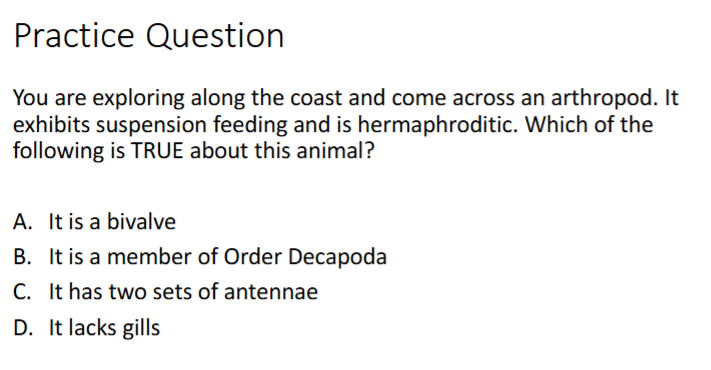
D.
why are insects so diverse?
outer strong exoskeleton
3 tagmata body plan
highly special feeding appendages (butterfly proboscis)
capable of flight
disperal to new habitats
search for mates and food easier
escape from adverse conditions
short generation time
metamorphosis
life stages of same bug dont compete
sensory, behavior, and communication modifications
co evolutionary interactions with other organisms, like plants
mdoes of insect development
ametabolous
no metamorpho
juveniles resemble adults and have molting until adulthood
hemimetabolous
incomplete meta
juvenile wingless nymph goes thru instars
adults dont molt, have wings, reproductive
holometabolous
complete meta
butterflies, bees, moths
wormlike wingless larvae goes thru instars
larvae makes non feeding pupa, tissues re differentate and emerges as an adult
organization of class insects*
based on wings and mode of development (amet → hemi -→ holo)
wingless insects
apterygota
first insects
ametabolous
ancient winged
wings cant fold
pterygota: odonata
dragonflies, hemimet
folded wings, hemimet
exopterygota
wings out OUTSIDE
termites, grasshoppers, mantis
folded wings, holo
endopterygota
wing buds on INSIDE
butterflies, bees, moths
** ig write this on paper :(
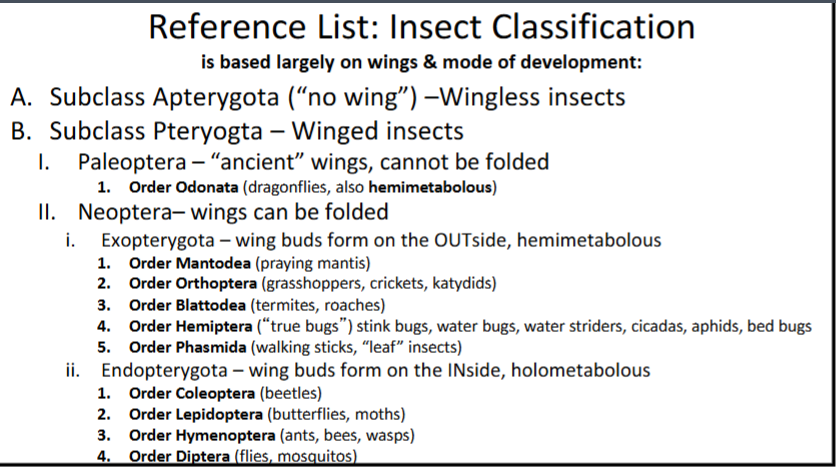
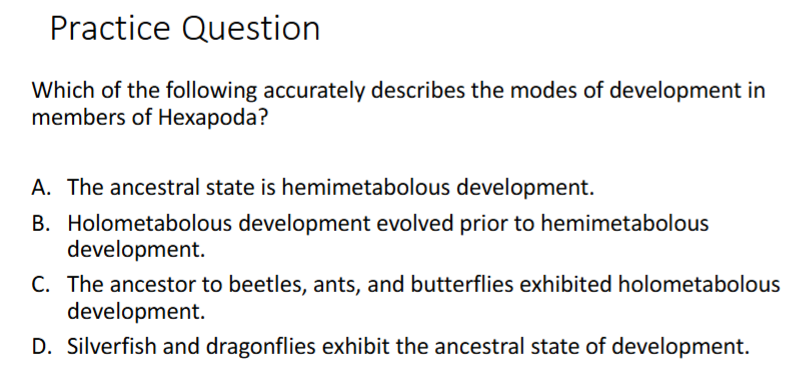
D.
how to remember deuterostome?
means second mouth. during gastrulation, blastopore first becomes the anus (we talk shit), and mouth forms secondarily
in protosomes the mouth develops from the blastopore, and the anus does too
protostome vs deuterostome differences*
cleavage
proto= spiral and determinate cleavage
deuter= radial and indeterminate cleavage, cells are totipotent for longer
coelem formation
proto= schizocoelous (split) coelom formation
deuter= enterocoelous formation
blastopore becomes
proto: mouth
deuter: anus, mouth forms separate
sea cucumbers
weird stuff
Symbiont:
pearlfish lives symbiotically inside their anus…
Worms, crabs, snails, are commensal and leave the anus at night to feed
Other symbionts are parasites and eat the organs (but can be regenerated)
Defense and regen
When provoked, sea cukes defensively discharge organs thry anus to deter predators
Bc organs sticky and toxic, like cuverian tubules in respiratory tree